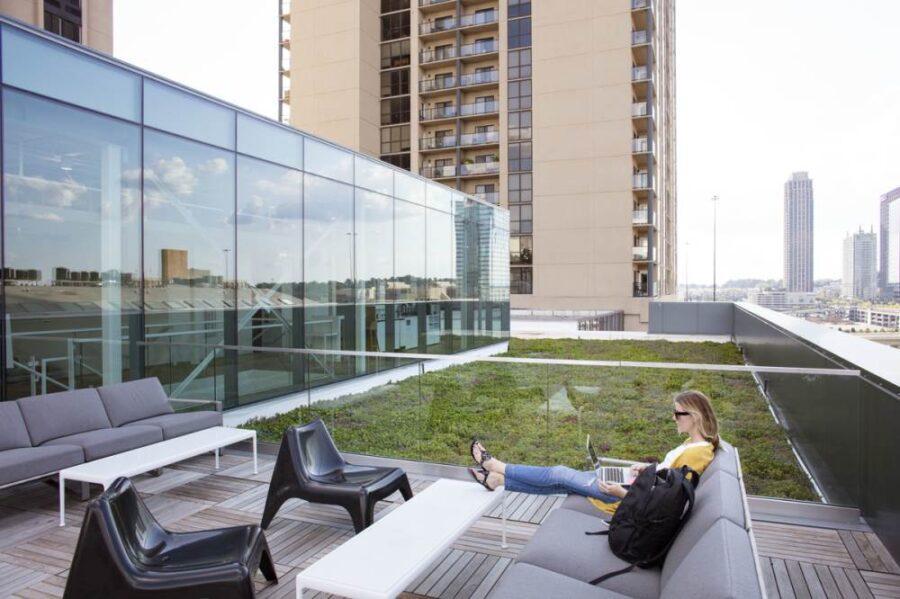During an average workday, office workers spend a lot of time seated behind their computers, typing, analyzing data, having meetings and communicating with colleagues and clients. Since they spend at least 8 hours a day at the office, it’s not a surprise that its design has a strong effect on the health and wellness of the workers. So how can an office be designed in a way that has a positive impact on the employees and boosts their health, happiness and well-being? Here are a few design points to follow:
Ergonomic seating
One of the most important things for workers is their seating because they spend most of their day at their desks. Chairs with proper support, practical desk layout and even standing desks might be a great ergonomic strategy for health and wellbeing. A proper seating position takes into consideration the neutral body position or a comfortable posture with all the joints and muscles aligned. This position prevents strain and stress on the neck, upper back and lower back and minimizes absenteeism due to chronic pain.
Tall workbenches
Did you know that working while standing (even just half an hour a day) can have a great impact on blood pressure, cholesterol and stress? Therefore, it’s crucial to introduce as much standing into your employees’ workday as possible. One way is to invest in sit-stand desks and tall workbenches for standing meetings. Standing meetings are very popular today and are a very efficient and pleasant way to communicate. Today, many offices have tall workbenches scattered around the premises so that people can have easy standing meetings.
Nurture the senses
People have always been using their senses to create connections with each other and the spaces around us. In your office, it’s important to employ all senses and allow them to enjoy triggers from the design. Sights of pleasant colors, greenery and natural daylight can have a great effect on the employees’ feelings. Sounds of clamor can boost adrenaline while quiet spaces can allow focus. Certain smells can boost concentration. The touch of different textures, especially heavy wood, can also create a big impact on workers. Investing in texturally rich and authentic Amish furniture that will boost the warmth and elegance of the space can be pleasurable for all senses. Looking and touching natural materials can relieve tension and improve focus.
Natural light
The sun is one of the biggest necessities of the human body and natural light awakens strong responses in humans. It’s important to boost natural light at the office if you want to see your staff healthier, more energetic and less stressed. Of course, it’s not possible to provide every office in the building with a natural light source, it is possible to utilize smart window design, open spaces and easier sunlight penetration throughout the space. Workers who get more sunlight usually report more stable mental health, lower stress and better productivity, all of which are crucial for performance.
Elevators and stairways
Elevators are very practical, but they do not promote enough activity. On the other hand, stairs help burn extra calories, activate the muscle and promote heart and lung health. If you’re just building your office space, consider giving the stairways the central position and placing elevators in the corner. This way, the stairs will be the easiest route to move from floor to floor and elevators will be reserved for longer trips and people with mobility issues. Also, make sure to make stair use even more attractive by playing calming music along the stairs, filling the hall with beautiful imagery and trying to evoke as many pleasant emotions as you can in stair users.
Collaboration spaces
Employees require two types of spaces: collaboration space and quiet private space. The first type is an excellent choice when it comes to boosting communication with colleagues and collaboration between teams and individuals. It is proven that people in open-plan offices filled with benches and modular furniture that can be pushed together have more activity throughout the day. On the other hand, some tasks require privacy and focus, so they need to be conducted in quiet spaces that are separated from the rest of the space. This dial setup allows all sorts of tasks to be finished with utmost pleasure and in complete comfort.
A touch of greenery
According to research, plants and shrubbery increase the oxygen levels in the office which in turn results in better concentration, mood, critical thinking and productivity. Plus, the color green reduces eye strain and stress—it’s a win-win situation. Think plants in unused office corners, living walls used as dividers and small succulents used as desk companions.
Office design has a more important role than previously thought. It’s not just there to look attractive to visitors, but also to improve the employees’ well-being, health and job satisfaction. With the tips above, you’ll manage to reduce absenteeism and boost staff retention, as well as improve the performance of your staff.



